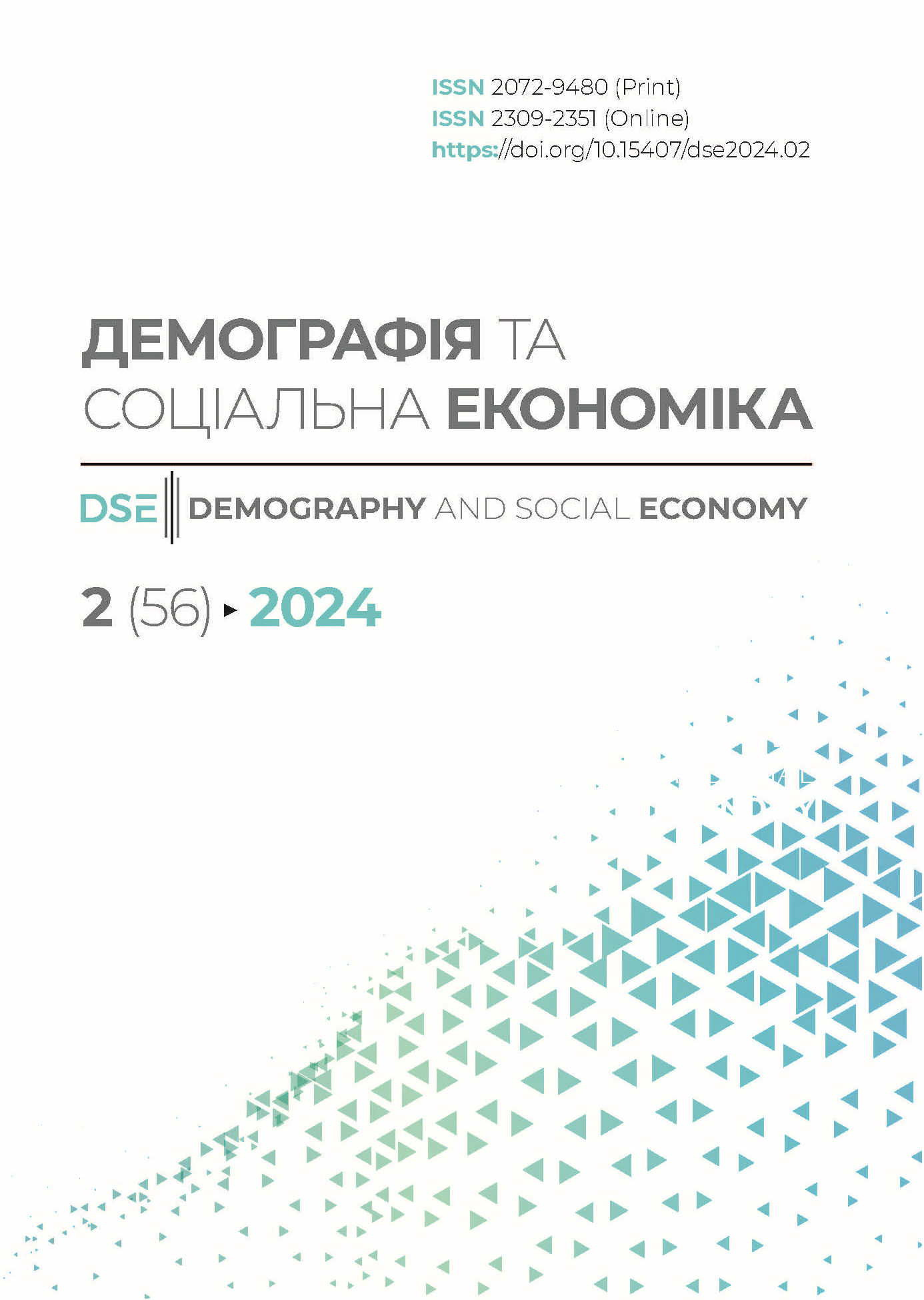SOME REGIONAL PECULIARITIES OF FORCED MIGRATION FROM UKRAINE: THE CAPITAL AND OTHER REGIONS
DOI:
https://doi.org/10.15407/dse2024.02.044Keywords:
International migration, forced migration, UkraineAbstract
The forced migration of Ukrainians within the country and abroad has become a characteristic feature of the era of full-scale invasion. It saved the lives and health of many people, as a decrease in population density in the areas most affected by the hostilities leads to a decrease in human losses. Despite the great research interest in the topic of forced migration, some aspects of it still remain poorly understood, in particular, it is important to study the peculiarities of forced migration at the localities level, at least in large cities. The purpose of this article is to single out the category of forced migrants who lived in Kyiv before the full-scale invasion by the aggressor country and to identify the peculiarities of staying abroad and the attitudes of this group. To achieve this goal, general scientific methods of analysis, synthesis, and induction were used. Empirical data were collected using the method of sample surveys. The method of grouping was used to distinguish Kyiv residents from the general population of respondents, and the method of comparison was used to identify the peculiarities of their forced migration abroad. The study found that Kyiv residents are more likely to settle abroad in the capitals of their destination countries. Among them, there are more unmarried and childless individuals, which creates prerequisites for socio-economic integration outside the country. Also, people from the capital were less likely to have relatives abroad at the time of the full-scale invasion, which is likely due to their low level of participation in external labor migration in the previous period. Migrants from the capital proved to be better integrated in the countries of settlement, which is reflected in their proficiency in the local language, employment in the local labor market, and higher levels of financial well-being. At the same time, they retain stronger ties to Ukraine. Residents of Kyiv region are similar to Kyiv residents in some respects, while in others they are similar to residents of other regions. The study also revealed cases where the population of Kyiv region exhibited characteristics intermediate between Kyiv and other regions. The development of effective strategies for migration management, socio-economic development of the country during the war and post-war revival needs to take into account regional specifics.
REFERENCES
- UNHCR Europe Bureau (July 2023). Life on Pause: Intentions and Prospects of Refugees from Ukraine. Regional intentions report No. 4. https://data.unhcr.org/en/documents/ details/105661 [in Ukrainian].
- Centre for Migration Research (February 2023). Between Ukraine and Poland: Ukrainian migrants in Poland during the war. CMR Spotlight, 2 (48) [in Ukrainian].
- Gradus Research (November 2022). Study of socio-political sentiments during the war. https://gradus.app/uk/open-reports/gradus-eu-wave-12-ua/ [in Ukrainian].
- Razumkov Centre (March 2022). Ukrainian Refugees: Attitudes and Assessments. https:// razumkov.org.ua/napriamky/sotsiologichni-doslidzhennia/ukrainski-bizhentsi-nastroita-otsinky [in Ukrainian].
- Razumkov Centre (April-May 2022). Attitudes and Assessments of Ukrainian Refugees Returning Home. https://razumkov.org.ua/napriamky/sotsiologichni-doslidzhennia/nastroi-taotsinky-ukrainskykh-bizhentsiv-shcho-povertaiutsia-na-batkivshchynu [in Ukrainian].
- Razumkov Centre (July-August 2022). Attitudes and Assessments of Ukrainian Refugees. https://razumkov.org.ua/napriamky/sotsiologichni-doslidzhennia/nastroi-ta-otsinkyukrainskykh-bizhentsiv-lypen-serpen-2022p [in Ukrainian].
- Laboratory of Legislative Initiatives (September 15, 2023). LSI presented a EU-supported study on the situation of Ukrainian refugees. https://parlament.org.ua/2023/09/15/lziprezentuvala-provedene-za-pidtrimki-yes-doslidzhennya-pro-stanovishhe-ukrayinskihbizhentsiv/ [in Ukrainian].
- Centre for Economic Strategy (2024). Ukrainian Refugees: Future Abroad and Plans to Return. Third wave of research. https://ces.org.ua/ukrainian_refugees_third_wave_research/ [in Ukrainian].
- American University Kyiv (2024). Presentation of the study “Way Home: Who among Ukrainian migrants and refugees plans to return”. https://www.youtube.com/watch?v= raok2qWdbOA [in Ukrainian].
- Glick Shiller, N., & Caglar, A. (2008). Migrant Incorporation and City Scale: Towards a Theory of Locality in Migration Studies. https://www.academia.edu/33691522/Migrant_ Incorporation_and_City_Scale_Towards_a_Theory_of_Locality_in_Migration_ Studies?email_work_card=title
- Molikevych, R. (2023). Forced Migrants from Occupied Kherson: Who, Where, Why, and How? European Journal of Geography, 14 (4), 53—65. https://doi.org/10.48088/ejg.r.mol. 14.4.053.065
- Bychay, R. (2023). State Migration Policy of Ukraine in Conditions of Martial Law: Implementation Problems. In: Modern Challenges for Migration Policy: Legal, Educational, and Historical Aspects: Proceedings of the Scientific-Practical Round Table (Sumy, June 24, 2023). P. 4—7. Sumy: Sumy State University.
- Blynova, Y. (2017). Social capital in the adaptation of forced migrants. In: Personality, Society, Law: Psychological Problems and Ways of Their Solution. Р. 79—81. Kharkiv. 60 ISSN 2072-9480. Demography and social economy. 2024, № 2 (56)Деякі регіональні особливості вимушеної міграції з України: столиця та інші регіони
- Bobrova, A., Lazarenko, V., Khassai, Ye., Filipchuk, L., Syrbu, O., & Lomonosova, N., et al. (2022). The First Days of Full-Scale War in Ukraine: Thoughts, Feelings, Actions. CEDOS.
- Ministry of Education and Science of Ukraine. (n.d.). How to organize education for Ukrainian children abroad: frequently asked questions and answers. https://mon.gov.ua/ua/ ministerstvo/diyalnist/mizhnarodna-dilnist/pidtrimka-osviti-i-nauki-ukrayini-pidchas-vijni/updated-potochni-vikliki-organizaciya-navchannya-dlya-ukrayinskih-ditejza-kordonom [in Ukrainian].
- Daley, A., Hu, M., & Warman, C. (2019). Language proficiency and immigrants’ economic integration. IZA World of Labor, 469. https://doi.org/10.15185/izawol.469
- Van Houte, M., Siegel, M., & Davids, T. (2016). Deconstructing the meanings of and motivations for return: an Afghan case study. CMS, 4 (21). https://doi.org/10.1186/ s40878-016-0042-y
Downloads
Published
How to Cite
Issue
Section
License
Copyright (c) 2024 Ірина Майданік

This work is licensed under a Creative Commons Attribution-NonCommercial-NoDerivatives 4.0 International License.


